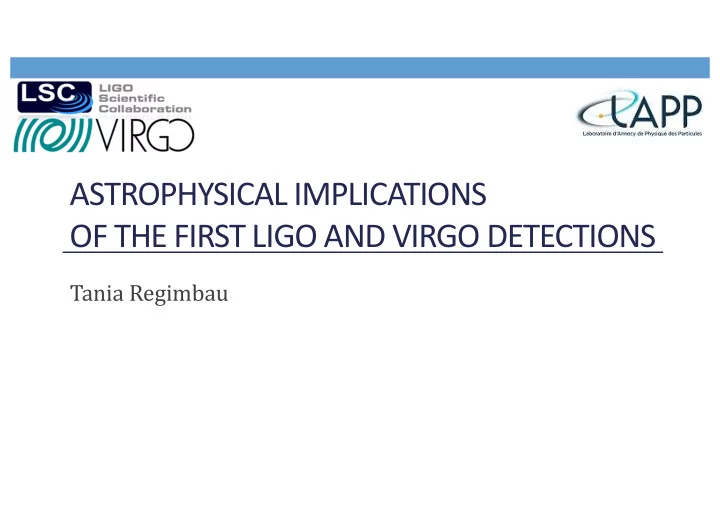

ASTROPHYSICAL IMPLICATIONS OF THE FIRST LIGO AND VIRGO DETECTIONS Tania Regimbau
2 LIGO Current Detections LIGO and Virgo have already observed 5 (+1?) BBHs and 1 BNS.
3 Possible Formation Scenarios § Field: formed from stars born in a binary system that remain bounded after the two supernovas (short or long delays). § Dynamical: formed by capture in a dense environment through mass segregation that move NSs and BHs to the center § Primordial BBH: formed by the collapse of dense regions in the very early Universe (hypothetical). Expected to have a large mass distribution. § We need more data to reconstruct the mass, spin (eccentricity) distribution
4 Compact objects masses § Black hole masses (m~7-30 Mo) can be larger than previously observed in XR-binaries. Must have been created in low metallicity environment. § We need more data to investigate the mass gap between NS and BH. § Already evidence for the heavy BH mass gap between 40-135 Mo (pulsational pair instability supernovae)
5 Spins Spin is the most promising parameter to distinguish between formation channels. Weak aligned spins favored
6 Rosetta stone GW170817 GW170817 was observed in both gravitational and electromagnetic waves (gamma, X-ray, ultraviolet, infrared, optical, radio). Host galaxy identified NGC 4993.
7 Rosetta stone GW170817 GW170817 was observed in both gravitational and electromagnetic waves (gamma, X-ray, ultraviolet, infrared, optical, radio). § sGRBs/BNS merger association (Fermi GRB 1.74 s delay) § kilonova/BNS (r process induced optical transient) § remnant objecy of 2.74 M s , light BH or heavy NS?
8
arXiv: 1805.11581 9 NS equation of state Small defomability parameter and then soft EOS favored
10 Abbott et al. Nature, 551, 85 (2017) Measurement of the Hubble Constant § Direct measurement of the luminosity distance with GWs Compared to supernovas, no need for distance ladder. + 8 Mpc d L = 40 − 14 § Optical identification of the host galaxy NGC4993. Measurement of the Hubble flow from the position and the redshift. Need to correct for the local peculiar velocity (~10%). Hubble law: v H = H 0 d (d<50 Mpc) §
11 Abbott et al. Nature, 551, 85 (2017) Measurement of the Hubble Constant + 12 km.s − 1 .Mpc − 1 H 0 = 70 − 8 Hubble law: v H = H 0 d (d<50 Mpc)
12 Abbott et al. Nature, 551, 85 (2017) Measurement of the Hubble Constant H 0 = 70 − 8 + 12 km.s − 1 .Mpc − 1
13 The Cosmological Population § Many more individual sources at larger distance § Contribute to create a stochastic background, which could be the next milestone for LIGO/Virgo § Carries lots of information about the star formation history, the metallicity evolution, the average source parameters (and then the main evolution scenarios). § Using information from the first observations, we were able to revise previous predictions of the GW background from BBHs and BNSs.
SGWB = noise
SGWB = symphony of the Universe
16 The Background Spectral Properties § Energy density in GWs characterized by: d ρ gw ( f ) Ω gw ( f ) = f ρ c df § For a population distributed in the parameter space θ= ( m 1 ,m 2 ,χ eff ) dE gw df ( θ , f (1 + z )) Ω gw ( f , θ ) = f 10 ∫ ∫ d θ P ( θ ) ( z , θ ) dzR m ρ c 4 π r 2 ( z ) 0 With rate: t max ∫ R m ( z , θ ) = R f ( z , θ ) P ( t d , θ ) dt d t min
17 Abbott et al. PRL, 120.091101 (2017) Estimate from Detected Sources + 1.2 10 − 9 Ω gw bbh (25Hz) = 1.1 − 0.7 Ω gw bns (25Hz) = 0.7 − 0.6 + 1.5 10 − 9
18 Abbott et al. PRL, 120.091101 (2017) Estimate from Detected Sources The background could be detected before the detectors reach design sensitivity!
Abbott et al. arXiv:1712.01168 Constraints on cosmic strings models § Topological defects which can be formed in GUT-scale phase transitions in the early Universe. They can produce large amount of GWs through the production of loops (cusps and kinks) G µ § Strings are charactarized by 2 parameters: tension and intercommutation probability p § We consider 3 different models of the number density n(l,t) based on Numbo- Goto numerical simulations ( p=1 ), and extend to p<1 assuming n ( l , t , p < 1) = n ( l , t , p = 1)/ p
Abbott et al. arXiv:1712.01168 Original Large Loop Distribution Loops chopped off the infinite string network are formed with the same relative size: l ( z ) = α t ( z )
Abbott et al. arXiv:1712.01168 Large loop distribution of Blanco Pillado et al. n(l,t) is extrapolated from numerical simulations. Assume that the momentum dependance of the loop production function is weak.
Abbott et al. arXiv:1712.01168 Large Loops Distribution of Ringeval et al. Distribution of non self interacting loops is extrapolated from numerical simulations. Include GW back reaction affecting the production of small loops.
Recommend
More recommend